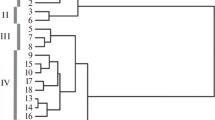Abstract
Results are presented of a survey of isozyme frequencies in parthenogeneticArtimia from six salterns in the Shandong Peninsula, P.R.C. Three of the eleven enzymes we scored using polyacryamide gel electrophoresis proved to be useful for analysis of electromorph frequency variation. These enzymes are tetrazolium oxidase (TO), lactate dehydrogenase (LDH), and malate dehydrogenase (MDH). Each of these systems showed extensive isozyme variation both within and between salterns. In addition, we have examined the possibility that electromorph frequencies may vary as the result of natural selection for adaptation to specific salinity, or salinity-associated environmental conditions. An indication of clinal variation was found in two series of ponds differing in salinity, however more extensive data are needed before it is possible to conclude that these patterns are the result of natural selection. Finally, the use of isozyme analyses such as ours, for unraveling taxonomic problems inArtemia is discussed.
Similar content being viewed by others
References
Abreu-Grobois, F. A. and J. A. Beardmore, 1980. Genetic characterization ofArtemia population: an eletrophoretic approach.In: The Brine ShrimpArtemia. Vol. 1. Morphology,Genetics Radiobiology, Toxicology. Persoone, G. P. Sorgeloos, O. A. Roels, E. Jaspers, eds. University Press, Wetteren, Belgium. 345 pp.
Abreu-Grobois, F. A. and J. A. Beardmore, 1982. Genetic differentiation and speciation in the brine shrimpArtemia.In: Barigozzi, C., ed. Mechanisms of Speciation Alan R. Liss, Inc., New York. pp. 245–376.
Bowen, S. T. and G. Sterling, 1978. Esterase and malate dehydrogenase isozyme polymorphisms in 15Artemia populations.Comp. Biochem. Physiol. 61B: 593–595.
Bowen, S. T., M. L. Davis, S. R. Fenster, and G. A. Lindwall, 1980.In: Persoone, B., P. Sorgeloos, O. Roels, and E. Jaspers, eds. The Brine ShrimpArtemia Vol. 1 Morphology, Genetics, Radiobiology. Toxicology Universa Press, Wetteren, Belgium. 345pp.
King, C. E., 1980. The genetic structure of zooplankton populations.In: Kerfoot, W. C. (ed.), Evolution and Ecology of Zooplankton Communities. New England University Press, pp. 315–329.
King, C. E., Y. Zhao, X. Liu, and M. R. Li. Polyacrylamide gel electrophoresis of isozyme variation inArtemia from Chinese salterns. MS submitted.
Lewontin, R. C. and J. L. Hubby, 1966. A molecular approach to the study of genic heterozygosity in natural populations ofDrosophila pseudo-obscura.Genetics 54: 595–609.
Maynard Smith, J. M., 1978. The Evolution of Sex. Cambridge University Press, Cambridge. 222pp.
Mayr, E., 1982. Questions concerning speciation.Nature 296: 609.
Vanhaecke, P., and P. Sorgeloos, 1980. International study onArtemia. XIV. Growth and survival ofArtemia larvae of different geographical origin in a standard culture test.Mar. Ecol. Progr. Ser. 3: 303–307.
Williams, G. C., 1975. Sex and Evolution. Monographs in Population Biology, No. 8. Princeton University Press, Princeton, N. J. 200pp.
Author information
Authors and Affiliations
Rights and permissions
About this article
Cite this article
King, C.E., Yuqi, Z., Xin, L. et al. Genetic variation in parthenogeneticArtemia from the Shandong Peninsula, P.R.C.. Chin. J. Ocean. Limnol. 6, 179–185 (1988). https://doi.org/10.1007/BF02847837
Received:
Issue Date:
DOI: https://doi.org/10.1007/BF02847837




